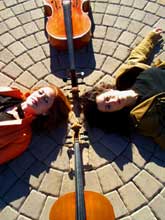Combination, Transformation: Jelloslave
Lightsey Darst and Jay Orff listened to Jelloslave's new CD "Touch It" --an adventurous leap of cellos. Their CD release party is February 18 (Saturday) at the Southern Theater, part of "Catalyst: An Electric Mix of New Music and Images."

JAY: Jelloslave is pushing what cellos can do, where they go, breaking free from the bounds of the string quartet and refusing to take their place in the first few rows of the orchestra. Not that I know what I’m talking about. In reference to their track “J.S. George,” I certainly come more from the George Harrison side of things than the J.S. Bach, but then Jelloslave is reaching out to people like me, people who have heard Bach’s solo cello suites but maybe don’t know their allegro from their Allegra.
That said, my favorite parts of their new CD, “Touch It,” are the parts where I’m not sure what sounds are the cellos or when it is abundantly clear, when they are on their own. In their attempts at cello revolution, for me the biggest victories are when the cellos take on the (old) world all by themselves.
LIGHTSEY: I also wish I heard more cello. The other elements are often witty (voices that say things like “exotic fruit,” the swish of bat wings, quirky beats), but the cellos themselves are the central magic here, a magic deeper than wit. It’s easy to become fascinated with their sound, which is at once like the human voice (warm, low, emotional) and like some malfunctioning clockwork (scraping, obsessive)—not to mention their seal-like, bird-like, and whalesong-like moments. Listening to the cello is like looking at an optical illusion: I hear the human, then the instrument, then the human playing the instrument. Jelloslave’s layered style—the two cellos playing across each other like water meeting water—and the rich sound of this recording add to the fascination.
On the other hand, I wonder, do we need all these sounds—detritus of the human-mechanical environment, of the ad-heavy, jangling world, the different voices of other instruments—to call out the particular life of the cellos? —as if the cellos were the original and the added sound the graffiti background against which we recognize this original? It may be. And yet I still wish I heard the cello leading more, partly because Jelloslave’s exploration of the cello is what I can’t hear elsewhere.
Although this CD is—what? jazz? quirky classical? traditional spiked? at any rate, some hybrid form—it’s quite listenable. This is not a CD you should pull out only when you are serious enough to pay attention or when you are inebriated enough not to have any attention to pay. It’s not dance music, but it could comfortably fill just about any other function.
But, on the other hand, by voyaging off in various directions—jazz, tango, modern (but not postmodern) classical, the Beatles—Jelloslave is risking unity of mood. The unity is the cello, but as Jelloslave so fully demonstrates, the cello is capable of many moods. There is a quiet flow through the CD, but I’d like a more unified mood as well. The question is, what mood? “Wendy Eating Winter,” the closing track, is a lovely, melancholy, structured piece, the voice of Jennifer Baldwin Peden floating above the dark hum of the cellos; “Prelude to the Afternoon of a Goosehonk” is an eerie, flickering lounge track. I like them both. Jelloslave has plenty of choices.
JAY: Yes, ultimately, I think the title of the CD refers simply to the beautiful and present sound of the cellos; it’s like being wrapped in fur, sensual and delightful to the ear, it’s a physical sensation. And the sad, lovely, overwhelming compositions do things that I always wanted cellos to do but have never heard before. It’s like seeing the first butterfly in April. When I see it I am excited, happy to see a butterfly again for the first time, and when I listen to Jelloslave I feel like I am hearing cellos again for the first time. I am mesmerized and want to see what they do next. And when other elements intrude, I want to focus on the cellos, fascinated by their movement.
When the drums kick in, the music flutters away, out of my mind but no doubt into someone else’s, and when the music goes into one of Tom Hambleton’s dramatic musical landscapes, I am again caught up in wonder. It’s the in-between bits that leave me waiting for the music to go one way or the other. Regardless, this CD goes a lot of places and is a compelling introduction to 21st century cello. I look forward to the next chapter.